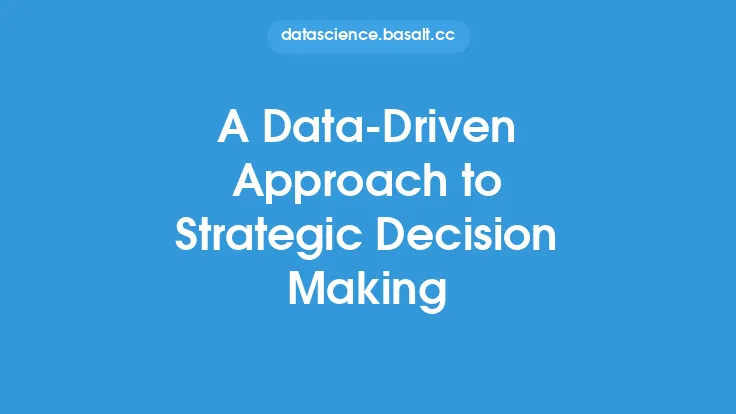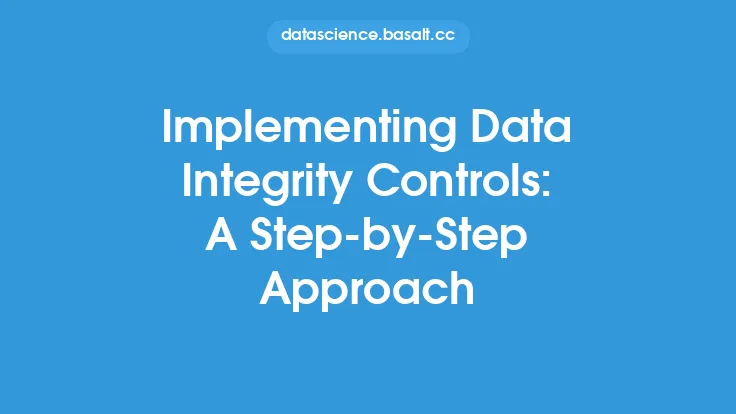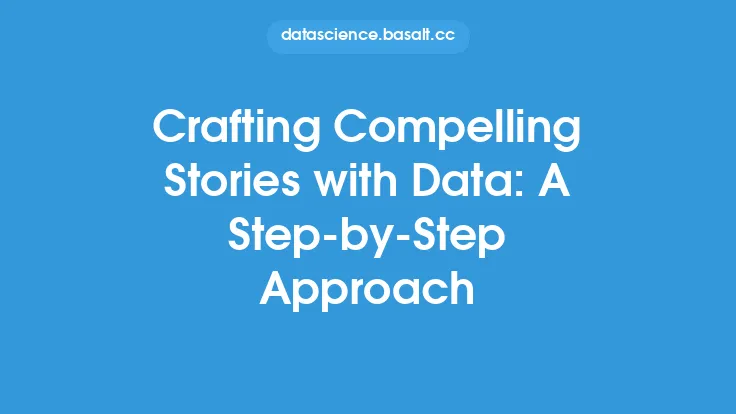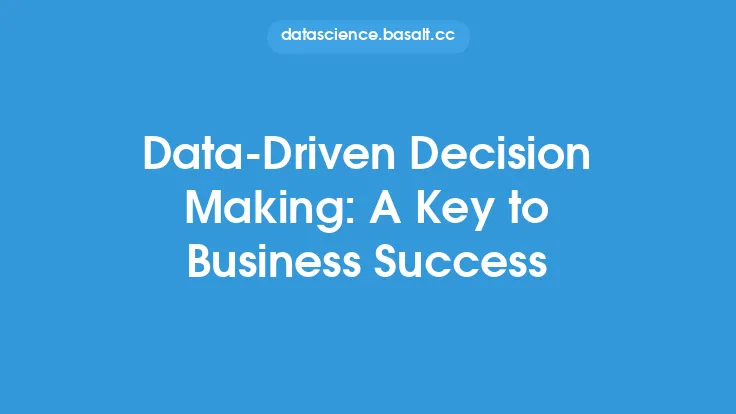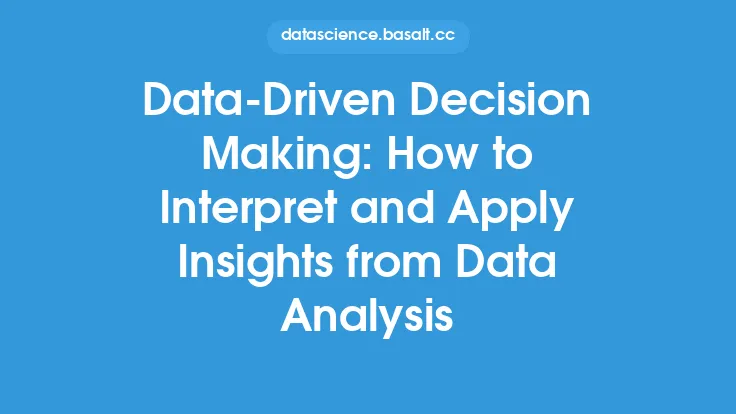In today's fast-paced business landscape, making informed decisions is crucial for driving growth, improving efficiency, and staying ahead of the competition. With the exponential increase in data generation, organizations have access to a vast amount of information that can be leveraged to make data-driven decisions. However, with so much data at their disposal, it can be overwhelming to know where to start and how to effectively use data to inform decision-making. In this article, we will provide a step-by-step approach to making data-driven decisions, covering the key concepts, tools, and techniques required to extract insights from data and drive business outcomes.
Understanding the Importance of Data-Driven Decision Making
Data-driven decision making is an approach that involves using data and analytics to inform business decisions, rather than relying on intuition or anecdotal evidence. This approach has become increasingly important in recent years, as organizations seek to optimize their operations, improve customer experiences, and drive revenue growth. By using data to inform decisions, organizations can reduce the risk of errors, improve the accuracy of forecasts, and identify new opportunities for growth. Moreover, data-driven decision making enables organizations to measure the effectiveness of their decisions and make adjustments as needed, ensuring that they are always moving in the right direction.
Defining the Decision-Making Problem
The first step in making data-driven decisions is to define the problem or opportunity that needs to be addressed. This involves identifying the key business questions that need to be answered, such as "What are the most profitable customer segments?", "How can we improve operational efficiency?", or "What are the key drivers of customer churn?". By clearly defining the problem, organizations can focus their data collection and analysis efforts on the most relevant information, ensuring that they are able to extract actionable insights that can inform decision-making.
Collecting and Preprocessing Data
Once the decision-making problem has been defined, the next step is to collect and preprocess the relevant data. This involves identifying the sources of data, such as customer relationship management (CRM) systems, enterprise resource planning (ERP) systems, or social media platforms, and extracting the relevant information. The collected data may be in various formats, such as structured, semi-structured, or unstructured, and may require preprocessing to ensure that it is clean, complete, and consistent. Data preprocessing techniques, such as data cleaning, data transformation, and data feature engineering, can be used to prepare the data for analysis.
Analyzing Data
With the data collected and preprocessed, the next step is to analyze it using various statistical and machine learning techniques. This involves applying algorithms and models to the data to identify patterns, trends, and correlations that can inform decision-making. Common data analysis techniques include regression analysis, clustering analysis, decision tree analysis, and neural network analysis. The choice of technique will depend on the nature of the problem, the type of data, and the desired outcome. For example, regression analysis can be used to forecast continuous outcomes, such as sales or revenue, while clustering analysis can be used to segment customers based on their demographic and behavioral characteristics.
Interpreting Results and Drawing Insights
After analyzing the data, the next step is to interpret the results and draw insights that can inform decision-making. This involves understanding the limitations and biases of the data, as well as the assumptions and uncertainties associated with the analysis. It is also important to consider the business context and the organizational goals and objectives, to ensure that the insights are relevant and actionable. Data visualization techniques, such as charts, graphs, and heat maps, can be used to communicate the insights and findings to stakeholders, making it easier to understand and act on the data.
Communicating Insights and Recommendations
The final step in making data-driven decisions is to communicate the insights and recommendations to stakeholders, such as business leaders, product managers, or marketing teams. This involves presenting the findings in a clear and concise manner, using storytelling techniques to make the data more engaging and accessible. It is also important to provide recommendations for action, based on the insights and analysis, and to identify the key performance indicators (KPIs) that will be used to measure the effectiveness of the decisions. By communicating the insights and recommendations effectively, organizations can ensure that the data-driven decisions are implemented and that the desired outcomes are achieved.
Implementing and Evaluating Decisions
After communicating the insights and recommendations, the next step is to implement the decisions and evaluate their effectiveness. This involves tracking the KPIs and metrics that were identified, and using the data to assess the impact of the decisions. It is also important to continuously monitor and refine the decisions, based on new data and insights, to ensure that they remain effective and relevant. By implementing and evaluating decisions in a data-driven way, organizations can ensure that they are always moving in the right direction, and that they are achieving their business goals and objectives.
Common Challenges and Pitfalls
While making data-driven decisions can be highly effective, there are also common challenges and pitfalls that organizations should be aware of. These include data quality issues, such as missing or inaccurate data, as well as biases and limitations in the data analysis. Additionally, organizations may face challenges in communicating the insights and recommendations to stakeholders, or in implementing the decisions and evaluating their effectiveness. To overcome these challenges, organizations should prioritize data quality, use robust and transparent data analysis techniques, and establish clear communication channels and feedback loops.
Best Practices for Data-Driven Decision Making
To ensure that data-driven decision making is effective, organizations should follow best practices, such as prioritizing data quality, using robust and transparent data analysis techniques, and establishing clear communication channels and feedback loops. Additionally, organizations should foster a culture of data-driven decision making, where data is valued and used to inform business decisions. This involves providing training and education to employees, as well as establishing clear governance and oversight structures to ensure that data is used responsibly and ethically. By following these best practices, organizations can ensure that they are making the most of their data, and that they are achieving their business goals and objectives.
Conclusion
Making data-driven decisions is a critical component of business success in today's fast-paced and competitive landscape. By following a step-by-step approach, organizations can extract insights from data and drive business outcomes. This involves defining the decision-making problem, collecting and preprocessing data, analyzing data, interpreting results and drawing insights, communicating insights and recommendations, implementing and evaluating decisions, and overcoming common challenges and pitfalls. By prioritizing data quality, using robust and transparent data analysis techniques, and establishing clear communication channels and feedback loops, organizations can ensure that they are making the most of their data, and that they are achieving their business goals and objectives.
